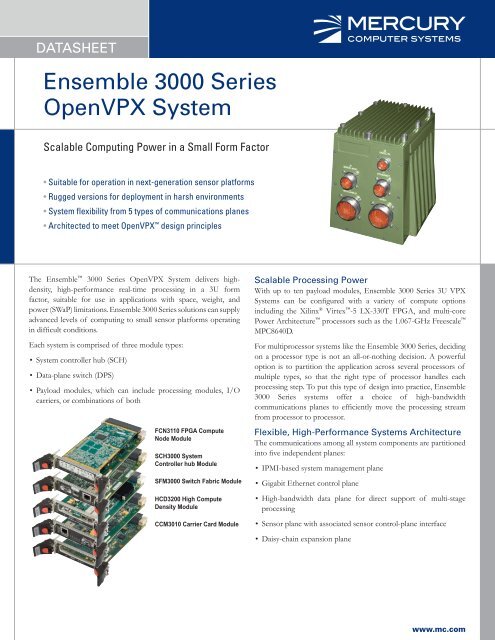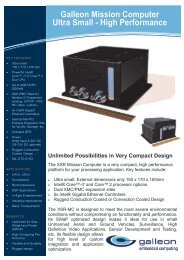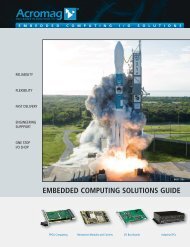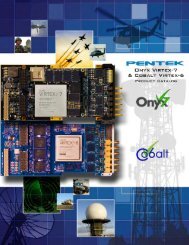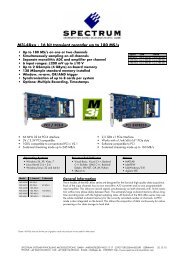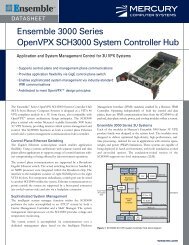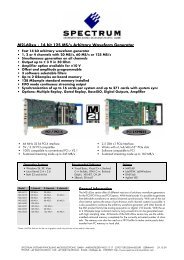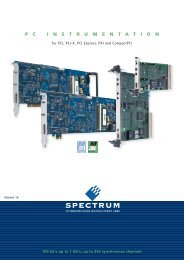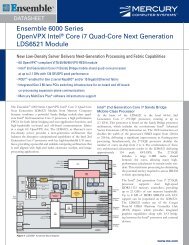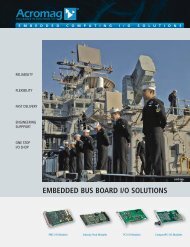Ensemble 3000 Series OpenVPX System - dynamic c4 pte. ltd.
Ensemble 3000 Series OpenVPX System - dynamic c4 pte. ltd.
Ensemble 3000 Series OpenVPX System - dynamic c4 pte. ltd.
Create successful ePaper yourself
Turn your PDF publications into a flip-book with our unique Google optimized e-Paper software.
DATASHEET<br />
<strong>Ensemble</strong> <strong>3000</strong> <strong>Series</strong><br />
<strong>OpenVPX</strong> <strong>System</strong><br />
Scalable Computing Power in a Small Form Factor<br />
Suitable for operation in next-generation sensor platforms<br />
Rugged versions for deployment in harsh environments<br />
<strong>System</strong> fl exibility from 5 types of communications planes<br />
Architected to meet <strong>OpenVPX</strong> design principles<br />
The <strong>Ensemble</strong> <strong>3000</strong> <strong>Series</strong> <strong>OpenVPX</strong> <strong>System</strong> delivers highdensity,<br />
high-performance real-time processing in a 3U form<br />
factor, suitable for use in applications with space, weight, and<br />
power (SWaP) limitations. <strong>Ensemble</strong> <strong>3000</strong> <strong>Series</strong> solutions can supply<br />
advanced levels of computing to small sensor platforms operating<br />
in diffi cult conditions.<br />
Each system is comprised of three module types:<br />
• <strong>System</strong> controller hub (SCH)<br />
• Data-plane switch (DPS)<br />
• Payload modules, which can include processing modules, I/O<br />
carriers, or combinations of both<br />
FCN3110 FPGA Compute<br />
Node Module<br />
SCH<strong>3000</strong> <strong>System</strong><br />
Controller hub Module<br />
SFM<strong>3000</strong> Switch Fabric Module<br />
HCD3200 High Compute<br />
Density Module<br />
CCM3010 Carrier Card Module<br />
Scalable Processing Power<br />
With up to ten payload modules, <strong>Ensemble</strong> <strong>3000</strong> <strong>Series</strong> 3U VPX<br />
<strong>System</strong>s can be confi gured with a variety of compute options<br />
including the Xilinx ® Virtex -5 LX-330T FPGA, and multi-core<br />
Power Architecture processors such as the 1.067-GHz Freescale <br />
MPC8640D.<br />
For multiprocessor systems like the <strong>Ensemble</strong> <strong>3000</strong> <strong>Series</strong>, deciding<br />
on a processor type is not an all-or-nothing decision. A powerful<br />
option is to partition the application across several processors of<br />
multiple types, so that the right type of processor handles each<br />
processing step. To put this type of design into practice, <strong>Ensemble</strong><br />
<strong>3000</strong> <strong>Series</strong> systems offer a choice of high-bandwidth<br />
communications planes to effi ciently move the processing stream<br />
from processor to processor.<br />
Flexible, High-Performance <strong>System</strong>s Architecture<br />
The communications among all system components are partitioned<br />
into fi ve independent planes:<br />
• IPMI-based system management plane<br />
• Gigabit Ethernet control plane<br />
• High-bandwidth data plane for direct support of multi-stage<br />
processing<br />
• Sensor plane with associated sensor control-plane interface<br />
• Daisy-chain expansion plane<br />
www.mc.com
The <strong>Ensemble</strong> <strong>3000</strong> <strong>Series</strong> SCH<strong>3000</strong> is a critical component,<br />
functioning as both a control-plane Ethernet switch and a<br />
system-management-plane communications hub/controller. The<br />
Gigabit Ethernet module’s control-plane switch enables<br />
application fl exibility. This architectural approach allows<br />
applications to support a range of control functions without<br />
compromising or being affected by data-movement operations.<br />
The system manager function within the SCH<strong>3000</strong> performs the<br />
tasks accomplished in an ATCA ® /MicroTCA ® system by a carrier<br />
management controller and a shelf manager. This comprehensive<br />
system control uses communications over a dedicated<br />
management plane based on the Intelligent Platform<br />
Management Interface (IPMI) standard. Operating independently<br />
of the control and data planes are IPMI communications lines<br />
from the SCH<strong>3000</strong> to the data-plane switch and the payload<br />
modules within a 3U VPX system.<br />
Built in Accordance with <strong>OpenVPX</strong> Design<br />
Principles<br />
The architecture of the <strong>Ensemble</strong> <strong>3000</strong> <strong>Series</strong> 3U VPX<br />
<strong>System</strong> complies with the guidelines established by the <strong>OpenVPX</strong><br />
Working Group. <strong>OpenVPX</strong> is an industry effort to establish<br />
system design principles and practices for implementing the VPX<br />
standard to ensure truly interoperable system components.<br />
Built for Harsh Environments<br />
Designed in compliance with VITA 46 and 48 standards<br />
(VPX-REDI), conduction-cooled versions of the <strong>Ensemble</strong><br />
<strong>3000</strong> <strong>Series</strong> 3U VPX <strong>System</strong>s are fully capable of deployment in<br />
harsh environments, including extreme ranges of temperature and<br />
humidity, high levels of shock and vibration, and poor air quality. Aircooled<br />
options are available for use in less demanding environments.<br />
Physical slot number<br />
Logical slot number<br />
Sensor Plane<br />
(4 lanes)<br />
Sensor Control Plane<br />
(4 lanes)<br />
Expansion Plane<br />
(4 lanes)<br />
Data Plane<br />
(4 lanes)<br />
Control Plane<br />
(1 lane)<br />
Management Plane<br />
(IPMB)<br />
VPX<br />
1<br />
1<br />
Sensor<br />
Plane<br />
Discrete<br />
I/Os<br />
Expan<br />
Plane<br />
Data<br />
Plane<br />
Control<br />
Plane<br />
IPMC<br />
VPX<br />
2<br />
2<br />
Sensor<br />
Plane<br />
Discrete<br />
I/Os<br />
Expan<br />
Plane<br />
Data<br />
Plane<br />
Control<br />
Plane<br />
IPMC<br />
Payload Slots Switch/Management<br />
VPX<br />
3<br />
3<br />
Sensor<br />
Plane<br />
Discrete<br />
I/Os<br />
Expan<br />
Plane<br />
Data<br />
Plane<br />
Control<br />
Plane<br />
IPMC<br />
VPX<br />
4<br />
4<br />
Sensor<br />
Plane<br />
Discrete<br />
I/Os<br />
Expan<br />
Plane<br />
Data<br />
Plane<br />
Control<br />
Plane<br />
IPMC<br />
VPX<br />
5<br />
11<br />
Sensor<br />
Plane<br />
Discrete<br />
I/Os<br />
Expan<br />
Plane<br />
Data<br />
Plane<br />
Control<br />
Plane<br />
IPMC<br />
Figure 1. <strong>Ensemble</strong> <strong>3000</strong> <strong>Series</strong> 3U VPX <strong>System</strong> Topologies<br />
VPX<br />
6<br />
5<br />
Control<br />
Switch<br />
VPX<br />
7<br />
6<br />
Data<br />
Switch<br />
External<br />
ChMC IPMC<br />
Advanced Reliability, Maintainability,<br />
and Availability<br />
The IPMI-based management plane communications support<br />
a range of sophisticated functions, including voltage and<br />
temperature monitoring.<br />
The conduction-cooled versions of all modules, including payload<br />
modules, offer the ability to support two-level maintenance (2LM).<br />
Three Styles of Data Movement<br />
<strong>Ensemble</strong> <strong>3000</strong> <strong>Series</strong> 3U <strong>OpenVPX</strong> <strong>System</strong>s offer three styles<br />
of data-plane operations, all of which can be used concurrently.<br />
Each application can implement the data movement style that<br />
best fi ts its processing model, or use multiple styles at different<br />
stages within complex models.<br />
The most fl exible mode of data-plane communications is via<br />
a high-bandwidth switch fabric. The <strong>Ensemble</strong> <strong>3000</strong> <strong>Series</strong><br />
SFM<strong>3000</strong> Data-Plane Switch provides a RapidIO ® data-plane<br />
switching function for low-latency, non-blocking, deterministic<br />
switching among eight of the ten payload slots. There is also a<br />
point-to-point RapidIO link between the two remaining payload<br />
slots. The channel to each module consists of 10-Gbps, fullduplex,<br />
serial RapidIO (4 x 3.125 Gbps, with 8/10 encoding).<br />
This style of high-bandwidth, RapidIO-based inter-processor<br />
communication is commonly used to achieve maximum throughput<br />
in applications that need to divide a single math operation, like<br />
an FFT, among multiple processors.<br />
A second style of data movement is via a point-to-point sensor<br />
plane. The ten payload slots within a system are organized fi rst<br />
into two four-slot groupings with direct, full-duplex 10-Gbps<br />
point-to-point links (4 x 3.125 Gbps, with 8/10 encoding) in the<br />
backplane among all members of a group. The two remaining<br />
VPX<br />
8<br />
12<br />
Sensor<br />
Plane<br />
Discrete<br />
I/Os<br />
Expan<br />
Plane<br />
Data<br />
Plane<br />
Control<br />
Plane<br />
IPMC<br />
VPX<br />
9<br />
7<br />
Sensor<br />
Plane<br />
Discrete<br />
I/Os<br />
Expan<br />
Plane<br />
Data<br />
Plane<br />
Control<br />
Plane<br />
IPMC<br />
Payload Slots<br />
VPX<br />
10<br />
8<br />
Sensor<br />
Plane<br />
Discrete<br />
I/Os<br />
Expan<br />
Plane<br />
Data<br />
Plane<br />
Control<br />
Plane<br />
IPMC<br />
VPX<br />
11<br />
9<br />
Sensor<br />
Plane<br />
Discrete<br />
I/Os<br />
Expan<br />
Plane<br />
Data<br />
Plane<br />
Control<br />
Plane<br />
IPMC<br />
VPX<br />
12<br />
10<br />
Sensor<br />
Plane<br />
Discrete<br />
I/Os<br />
Expan<br />
Plane<br />
Data<br />
Plane<br />
Control<br />
Plane<br />
IPMC<br />
FPGA Clusters<br />
and Sensor Control<br />
<strong>OpenVPX</strong>
payload slots are directly linked with each other in the same<br />
manner. These links can support RapidIO, 10 Gigabit Ethernet,<br />
or the Aurora protocol. This style of data movement delivers<br />
maximum performance for algorithms like beamforming, which<br />
require coherence among processors.<br />
The third style of data movement uses the expansion plane,<br />
linking adjacent slots with direct backplane communications in<br />
a daisy-chain fashion using 16-Gbps PCI Express ® links (8 x 2.5<br />
Gbps, with 8/10 encoding). This style fi ts well with applications<br />
that bring in high-bandwidth I/O from multiple channels<br />
simultaneously and need to move it effi ciently to the fi rst stage<br />
of processing.<br />
Software Environment<br />
The <strong>Ensemble</strong> <strong>3000</strong> <strong>Series</strong><br />
supports the nextgeneration<br />
MultiCore Plus ® software environment, which<br />
offers application portability among Mercury platforms.<br />
MultiCore Plus incorporates open standards such as Linux ® ®<br />
and<br />
the Eclipse IDE. The popular Mercury algorithm suite, Scientifi c<br />
Algorithm Library (SAL), in both its single-core and multi-core<br />
(MC SAL) versions, is included in the Mercury MathPack<br />
software package.<br />
Software Development Target Production <strong>System</strong><br />
Eclipse Framework<br />
Mercury Today<br />
TATL<br />
SUPERVISOR<br />
MultiCore Debug<br />
VMC<br />
3rd-Party IDE Plug-ins<br />
Figure 2. MultiCore Plus Software Tools Environment<br />
Applications<br />
<strong>Ensemble</strong> <strong>3000</strong> <strong>Series</strong> 3U <strong>OpenVPX</strong> systems have a unique blend<br />
of high-performance real-time processing and ultra compact<br />
packaging, making them ideal for communications, sensor, and<br />
signal processing applications in space- and weight-constrained<br />
deployments, such as small, unmanned air and ground vehicles.<br />
The processing architecture and performance can accommodate<br />
diverse payload applications including:<br />
• Radar<br />
• Electro-optic/infrared (EO/IR)<br />
• Mission computing<br />
• Signals intelligence<br />
OpenFDK - SVE<br />
ICS<br />
TimeStorm FPGA Driver (FDK) Extended OS<br />
Windows - Linux<br />
Customer Applications<br />
FPGA IP (FDK)<br />
TCP/IP<br />
Ethernet RIO<br />
Third-Party CSN Enabling Software Customer IP<br />
MPI<br />
OFED<br />
VxWorks BSP<br />
HIGH AVAILABILITY<br />
MultiCore MathPack<br />
SYST. MGT. SVCS<br />
DIAGNOSTICS<br />
RT Linux LSP<br />
Specifi cations<br />
Software MultiCore Plus Software Platform<br />
Development tools MultiCore Plus and MathPack 1.0<br />
Operating system support Linux ®<br />
Available Modules<br />
High compute density<br />
Freescale MPC8640 dual-core running at 1.067 GHz<br />
Xilinx Virtex-5 LX-330T or LX-110T<br />
Carrier card XMC site<br />
Carrier card with FPGA XMC site and Virtex-5 LX-330T<br />
<strong>System</strong> controller hub<br />
1 GigE control plane switch, system management hub<br />
Data-plane switch 10-Gbps RapidIO<br />
Internal Communications<br />
RapidIO<br />
One 10-Gbps full-duplex link to each payload slot<br />
Aurora, RapidIO, 10 Gigabit Ethernet<br />
Direct 10-Gbps full-duplex links among grouped payload slots<br />
PCI Express<br />
Direct 16-Gbps full-duplex links between adjacent payload slots<br />
Gigabit Ethernet<br />
1-Gbps full-duplex link to each payload slot<br />
IPMI<br />
400-Kbps I 2 C link to each payload slot<br />
12-Slot Air-Cooled Chassis<br />
Size (excluding connectors) 7U 19-in rackmount chassis<br />
Height 12.22 in<br />
Width 16.45 in<br />
Depth 17.0 in<br />
Card cage 12 slots on 1-inch pitch<br />
Power supplies<br />
Two, each with 750W max output<br />
Cooling<br />
Forced convection (15 CFM min per slot)<br />
~60W per slot at 50°C inlet temperature<br />
Air-Cooled Chassis Environmental<br />
Temperature<br />
Operating 0°C to 50°C up to 10,000 ft MSL<br />
Storage -40°C to +100°C<br />
Humidity 3-95% relative humidity, non-condensing<br />
Shock MIL-S-901 (15g at 40 ms, 30g at 20 ms, 100g at 5 ms)<br />
Vibration MIL-STD-167-1, Telcordia GR-63-CORE (NEBS)<br />
www.mc.com
Some of Mercury’s products are subject to the jurisdiction of the U. S. International Traffi c in Arms Regulations (ITAR). Please contact your Mercury sales representative for more information.<br />
<strong>Ensemble</strong> and Challenges Drive Innovation are trademarks of Mercury Computer <strong>System</strong>s, Inc. RapidIO is a registered trademark of the RapidIO Trade Association. <strong>OpenVPX</strong> is a trademark of VITA. Other<br />
products mentioned may be trademarks or registered trademarks of their respective holders. Mercury Computer <strong>System</strong>s, Inc. believes this information is accurate as of its publication date and is not responsible<br />
for any inadvertent errors. The information contained herein is subject to change without notice.<br />
Copyright © 2009 Mercury Computer <strong>System</strong>s, Inc. 1982.02E-1209-DS-3uvpxsys<br />
Corporate Headquarters<br />
201 Riverneck Road<br />
Chelmsford, MA 01824-2820 USA<br />
+1 (978) 967-1401 +1 (866) 627-6951<br />
Fax +1 (978) 256-3599<br />
www.mc.com<br />
Europe<br />
Mercury Computer <strong>System</strong>s, Ltd.<br />
Unit 1 - Easter Park, Benyon Road Silchester, Reading RG7 2PQ UNITED KINGDOM<br />
+ 44 0 1189 702050 Fax + 44 0 1189 702321<br />
Asia<br />
Nihon Mercury Computer <strong>System</strong>s K.K.<br />
No. 2 Gotanda Fujikoshi Bldg. 4F 5-23-1 Higashi Gotanda Shinagawa-ku, Tokyo 141-0022 JAPAN<br />
+81 3 3473 0140 Fax +81 3 3473 0141<br />
Challenges Drive Innovation


